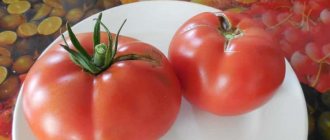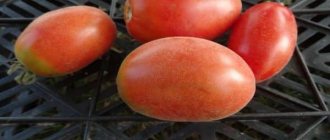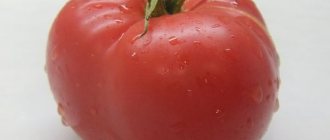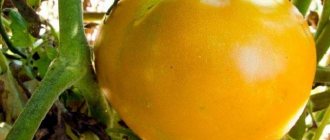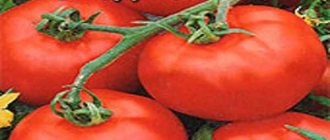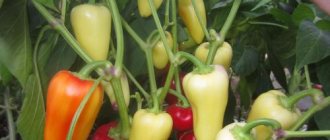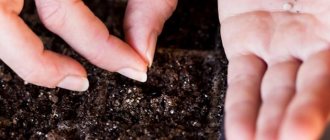One of the most famous varieties is the Golden Raspberry Miracle tomato. Their popularity is due to the unique bright color of ripe fruits, soft structure, huge size and excellent taste.
The undeniable advantages of this complex are noted not only by numerous reviews from summer residents, but also by representatives of the Russian agro-industrial exhibition, who awarded the variety a gold medal. It was this fact that served as the beginning of the development of several series of tomatoes, each of which has its own individual characteristics.
Description of tomatoes Raspberry miracle
In total, 3 collections of tomatoes in the series were created, which, thanks to the award, were named the Golden Raspberry Miracle, 5 varieties each. All of them are represented by determinate plants that need staking and bush formation. On powerful stems 70–100 cm high, there are medium-sized leaves, and intermediate inflorescences. Large salad fruits of raspberry color and medium density are covered with a thin, durable skin that is not prone to cracking with changes in temperature and humidity. In the reviews, gardeners describe their experience of growing Raspberry Miracle tomatoes and present photos of varieties from different series.
The first series is the most homogeneous in terms of the morphological characteristics of its constituent varieties. Raspberry Sunset, Raspberry Wine and Bright Robin are early ripening, Raspberry Paradise and Raspberry Berry are mid ripening. All of them produce round, smooth, large fruits with an average weight of 340–500 g, and are characterized by a yield of 10–12 kg/sq. m in open ground and 12–14 kg/sq. m in a greenhouse.
Tomato varieties of the second and third series are more heterogeneous, differing in terms and volumes of fruiting, shape and size of fruits.
Episode 2:
| Variety name | Fruit characteristics | Fruiting | Productivity | ||
| Form | Weight, g | In open ground kg/sq. m | In the greenhouse kg/sq. m | ||
| Raspberry Joy | ovoid slightly ribbed | 95–125 | early ripening | 13,5 | 15 |
| Raspberry bison | rounded slightly ribbed | 320–350 | mid-early | 10 | 12,7 |
| Raspberry Dream | flat-round slightly ribbed | 380–420 | early ripening | 12 | 14,5 |
| Raspberry desirable | flat-round slightly ribbed | 380–420 | mid-early | 12,7 | 13,7 |
| Raspberry King | flat-round slightly ribbed | 300–340 | mid-early | 10 | 11,7 |
Episode 3:
| Variety name | Fruit characteristics | Fruiting | Productivity | ||
| Form | Weight, g | In open ground kg/sq. m | In the greenhouse kg/sq. m | ||
| Raspberry surprise | flat-round slightly ribbed | 300–350 | early ripening | 12 | 14,3 |
| Raspberry popsicle | rounded slightly ribbed | 300–320 | mid-early | 13,5 | 14,5 |
| Raspberry hero | flat-round slightly ribbed | 480 | mid-early | 12 | 15,5 |
| Raspberry bunny | rounded slightly ribbed | 300–350 | early ripening | 10,6 | 12,7 |
| Raspberry miracle | heart-shaped slightly ribbed | 250–330 | mid-early | 12,7 | 13,5 |
First episode
The first series includes 5 hybrids:
- Bright robin is an early ripening hybrid that produces a harvest 90 - 100 days after planting. It is unpretentious and has a high yield: on average, 15 kilograms of vegetables are harvested from 1 square meter. Tomatoes, with an average weight of 550 g, are characterized by an interesting taste, compared by many summer residents with a ripe watermelon.
- Crimson Sunset is a mid-early hybrid. The first harvest can be obtained after 90 - 110 days from the moment the seedlings are transplanted into the ground. Ripe vegetables are characterized by a round shape and an average weight of 400 - 700 g. Almost all tomatoes ripen at the same time. The skin has a bright shade, similar to the pink of the berry of the same name, and the pulp has a rich sweetish taste. It is characterized by tall growth: in a greenhouse, the bush can grow up to 200 centimeters. The hybrid was launched in 2008. During this time, I managed to receive high marks and positive reviews from gardeners for my productivity: on average, from 1 square meter of plantings you can harvest 14 - 18 kilograms of vegetables. Another advantage is resistance to diseases, with the exception of blossom end rot. There is also a drawback: the bush is very capricious and requires proper watering, lighting and temperature conditions.
- Raspberry berry is a variety distinguished by medium-sized vegetables, the average weight of which ranges from 300 to 500 g. A ripe tomato has a bright color and juicy pulp. It is used for growing crops not only in greenhouse conditions, but also in open ground. The hybrid is demanding on certain watering and lighting conditions.
- The creation of Raspberry wine, which is also called a miracle, dates back to 2009. The Raspberry Miracle tomato harvest ripens 107 days after transplanting into the ground. Ripe fruits are round in shape and pink in color. Their average weight is 300 g. The harvested crop can be transported over long distances and stored until winter.
- The Raspberry Paradise variety allows you to grow tomatoes with a sweetish fruity flavor. This crop is early ripening: the average ripening period is 90 days. In greenhouse conditions, the bush can grow up to 2 meters in height. The average weight is 550 grams, the fruit is round in shape with characteristic ribbing in the area of the stalk.
See also
Characteristics and description of the tomato variety Indoor Surprise, yield and cultivationRead
Each variety described is popular among gardeners.
Characteristics of tomatoes Golden Raspberry Miracle
The tables give the average weight of tomatoes, but they can reach 700-800 g. During fruiting, the weight of the fruit gradually decreases. They are fleshy, with a small number of chambers and seeds. Tomatoes of all varieties have a harmonious sweet and sour taste.
Productivity and fruiting
All varieties begin to bear fruit after 90–100 days and are capable of producing up to 15 kg per bush. Although tomatoes from the Raspberry Miracle series are not picky in their care, to obtain a good harvest it is necessary to follow the basic rules of agricultural technology and crop rotation. This concerns the choice of site, conditions for growing seedlings, timing of planting in a permanent place, compliance with temperature and humidity conditions, timely pinching, weeding, and fertilizing. On social networks you can find many photographs and enthusiastic reviews about the yield of Raspberry Miracle tomatoes.
Area of application of fruits
Raspberry miracle is a salad variety of tomatoes that are not intended for whole preservation. This is due to the large size of the fruit. Juice is squeezed out of these tomatoes, vegetable stews and sauces are prepared, they can be covered for the winter in sliced form - including as part of winter salads and soup dressings.
Resistance to diseases and pests
Golden Raspberry Miracle tomatoes are immune to late blight; to protect against other viral and fungal diseases, preventive measures should be taken and diseased bushes should be treated in a timely manner. They should not be planted after potatoes, eggplants and bell peppers. Potatoes are also an undesirable neighbor for tomatoes. To prevent infection, you need to avoid thickening the plantings, remove the lower leaves, pull out the weeds, and regularly loosen the soil.
Attention! Diseases and pests affect healthy plants less than weakened ones. Controlled watering and balanced fertilizing - including foliar feeding - will help tomatoes of this variety independently resist infection.
Advantages and disadvantages of the variety
Tomatoes of the “golden” series have characteristics thanks to which this variety finds more and more new fans every year. In their reviews of Golden Raspberry Miracle tomatoes, gardeners highlight the following advantages:
- harmonious taste and attractive presentation of the fruit;
- high productivity;
- good tying in adverse weather conditions;
- durability during transportation;
- suitability for long-term storage;
- adaptability to weather changes and sudden temperature changes.
The disadvantages of hybrid tomato varieties include one factor - the seeds contained in the grown fruits are unsuitable for sowing; nothing will grow from them. Every year you will have to buy new seed material.
Reviews
With reviews of tomatoes from the “Golden Raspberry Miracle” series. You can immediately discard the “professional” reviews written as a carbon copy - they, of course, contain only delight and beautifully taken photos. The rest can be divided into three groups:
- There are few wholly positive ones. The authors like the yield, resistance to late blight, taste, and wonderful appearance. They are written in a lively, non-advertising language, and their authors are not “fresh writers”. I think they should be taken into account.
- Ambiguous – the authors like the yield, but don’t like the taste. They find tomatoes too hard and not sweet enough. These reviews should definitely be taken into account.
- Negative - there are either very few ovaries or none at all. There are suspicions that their authors did something very wrong or are just making things up a little.
What conclusions can be drawn from all that has been written? Probably, Raspberry Miracle tomatoes are not always as good as in the photo and in advertising texts from Gardens of Russia. How different the reality is from advertising can only be known after several years of cultivation.
Raspberry varieties of tomatoes have long been popular among summer residents. Lately, many gardeners have heard of the Raspberry Miracle tomato seeds.
Growing rules
The Raspberry Miracle tomato varieties are suitable for cultivation in all regions of Russia where agriculture exists. It is preferable to sow the seeds first for seedlings, and only then plant them in a permanent place - in a greenhouse or open ground.
Planting seedlings
Sowing should be done in early spring - in the first ten days of March, using special containers for this. The soil should be light and fertile; a mixture of garden soil, sand, humus, peat and vegetable compost is recommended. The seeds of this tomato variety do not need to be buried; a layer of soil should cover them no more than 1 cm. The containers should be covered with glass or film and placed in a warm, bright place, the optimal temperature is 18–25 °C. The soil must be moistened every day.
With the appearance of the first true leaves (after 7–10 days), the tomato seedlings are planted in separate pots.
Advice! It is not necessary to pinch the central root; moreover, this will delay the start of fruiting by 10 days.
Tomato transplant
When the plants become stronger, they are moved to a permanent place, providing support for the stems. Tomatoes are transplanted into open ground after stable positive temperatures have established and the danger of night frosts has passed. The interval should be observed: between bushes - 60 cm, between rows - 70 cm.
Subsequent care for tomatoes
It is recommended to form Raspberry Miracle tomatoes into 2 stems; the remaining stepsons should be removed. The plant is growing rapidly, forming heavy multiple clusters, which will need to be tied up all season. Tomatoes are very demanding of moisture; drip watering at the root is preferable. To avoid the formation of a crust on the soil surface, regular loosening is recommended. It is useful to mulch the soil at the base of the plant - this helps retain moisture and provides additional nutrition to the roots. Tomatoes prefer feeding with superphosphate, peat, manure, ash; all the necessary elements are found in complex fertilizers.
Description and characteristics of the variety
Tomato Raspberry Heart F1 belongs to the category of large-fruited hybrid indent varieties. In the average period (after 112–120 days) it bears raspberry tomatoes. The variety has a salad purpose and can be used in preparations.
Features of the variety from the originator Gardens of Russia:
- vigorous bushes;
- stem height - 1.5 m;
- indeterminate type of growth;
- large fruit;
- mid-ripening.
Cultivation is carried out in open and closed beds (greenhouse and greenhouse conditions). The fruits are used in slices, snacks, and for making sauces.
Description of tomatoes:
- average weight - 300–600 g;
- large tomatoes weigh 1–1.2 kg;
- shape - an even heart;
- coloring - raspberry;
- the skin is matte, strong;
- pulp - dense, slightly juicy;
- The taste is balanced between sweetness and sourness.
Pest and disease control
It is necessary to regularly inspect tomatoes to identify diseases and harmful insects at an early stage. Timely and prompt response is the key to success in the fight against infestations. Spraying the bush and the ground around it with Bordeaux mixture, copper sulfate, and dusting with ash are effective against fungal infections. Of the chemical agents, Oxychom, Profit, Kartotsid are effective, but the biological preparations Trichodermin, Planriz, Fitolavin, Alirin B are preferable. They are able to restore soil microflora, neutralize the consequences of non-compliance with crop rotation, stimulate growth, and increase their resistance to disease.
In the fight against tomato pests, biological products Bitoxibacillin and Fitoverm are also used as a healthy alternative to insecticides. They are safe for humans, animals, beneficial insects, and at the same time affect parasites.
History of origin and selection collections
“Raspberry miracle” is the merit of scientist Lyubov Myazina from the scientific and production association “Gardens of Russia”; she selected the variety in the 90s. XX century In 2014 the result of her work was awarded a gold medal at VDNH; since then, among summer residents and other farmers, the variety has been given another name, “Golden Raspberry Miracle.”
Photo: Seeds series 1
Photo: Seeds series 2
Photo: Seeds series 3
“Raspberry Miracle” tomatoes are usually divided into 3 series and the corresponding varieties in each; let’s look at them in more detail.
Episode 1 “Crimson Miracle”
The 1st series collection is represented by unpretentious varieties that take root in any climate. Distinguished by productivity, aftertaste of watermelon and fruit.
- "Crimson Sunset";
- "Raspberries";
- "Raspberry wine";
- "Bright Robin";
- "Raspberry Paradise"
Photo: Representatives of the 1st series of Raspberry Miracle tomatoes
Episode 2 “Crimson Miracle”
Hybrid 2 series is characterized by the perfect taste of the fruit. The bushes are powerful, produce a good harvest, and need staking.
Photo: Representatives of the 2nd series of Raspberry Miracle tomatoes
| Subspecies | Characteristic |
| Raspberry Joy |
The pulp is sugary and tender. Ideal for fresh consumption, pickling and all types of preservation. |
| Raspberry bison |
The pulp is sweet and tender. Suitable for all types of preservation. |
| Raspberry Dream |
Suitable for fresh consumption, making seasonings, tomatoes and adjika. |
| Raspberry desirable |
High yield. The sweet taste of the pulp is perfect for fresh consumption and preservation in the form of seasonings, salads, etc. |
| Raspberry King |
The flesh is fleshy, the skin is dense. Suitable for long-term storage and preservation in whole fruit form. |
Episode 3 “Crimson Miracle”
The productive 3 series is popular among gardeners. They are characterized by excellent fruit taste and unpretentiousness.
Photo: Representatives of the 3rd series of Raspberry Miracle tomatoes
| Subspecies | Characteristic |
| Raspberry surprise |
The taste of tomatoes is harmonious. Suitable for preservation in whole fruit form, as well as for adjika and tomatoes |
| Raspberry popsicle |
The pulp is tender, the skin is thin. It is preferable to use fresh and for preservation in the form of ketchup, tomatoes and adjika. |
| Raspberry hero |
The skin is dense, so housewives prefer to use the variety for canning in the form of tomatoes, seasonings and salads. |
| Raspberry bunny |
The flesh is fleshy and sweet, the skin is dense. Suitable for fresh consumption and canning in various forms. |
| Raspberry Heart |
The fruits are tender, sweet and fragrant. Ideal for pickling, canning in all forms and eating fresh. |
Raspberry miracle is a tomato with good transportability. They are cultivated for mass sale or consumption.
